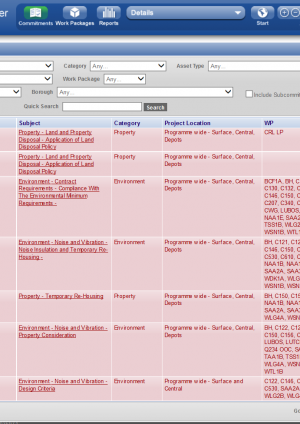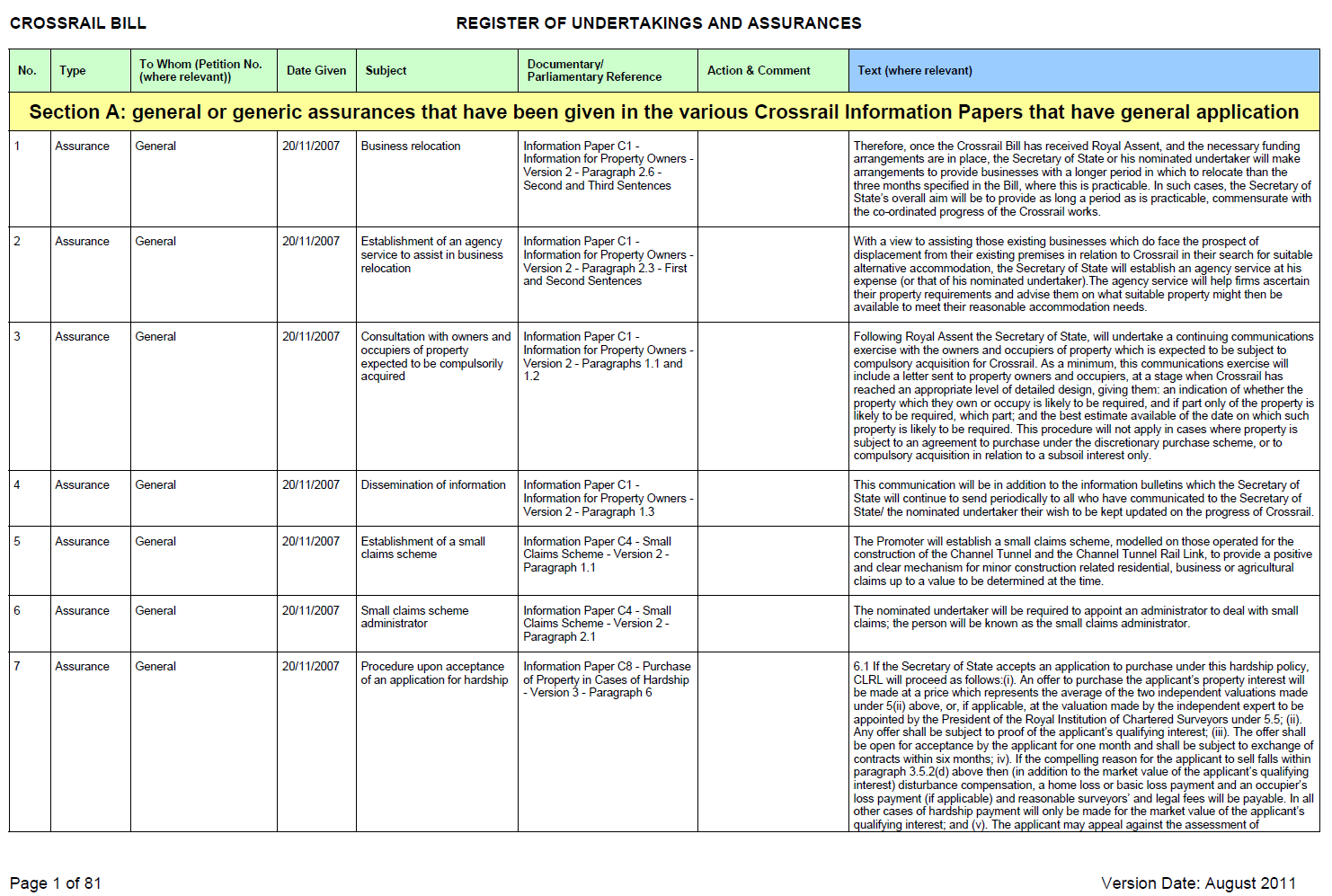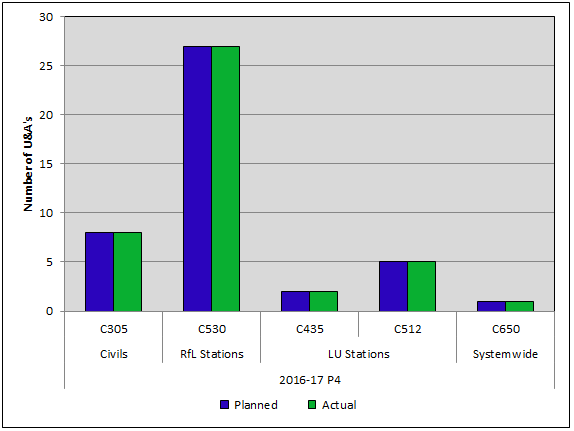
Managing Undertakings and Assurances
Document
type: Micro-report
Author:
Iftikhar Abutin
Publication
Date: 14/08/2018
-
Abstract
During the passage of the Crossrail Bill, the Secretary of State gave a number of undertakings and assurances (U&As) to Parliament and/or petitioners concerning the Crossrail project. These were recorded in an official register, held by the Department for Transport (DfT) known as the Register of Undertakings & Assurances.
The U&As were binding on all those carrying out the work. This micro-report explains the processes and systems used to manage and track compliance and the lessons learned.
-
Read the full document
Introduction and Industry Context
During the passage of the Crossrail Bill, the Secretary of State gave a number of undertakings and assurances (U&As) to Parliament and/or petitioners concerning the Crossrail project. These were recorded in an official register, held by the Department for Transport (DfT) known as the Register of Undertakings & Assurances. The process followed the successful template provided by the Channel Tunnel Rail Link project during the passage of the Channel Tunnel Rail Link Bill.
The register is a list of the commitments given, and to whom. It does not give the detail of each undertaking or assurance, and may instead in some cases simply refer to other documents (such as signed undertakings between the Secretary of State and the party concerned). The register should be read in conjunction with other documents that together with the Register are part of the Crossrail Environmental Minimum Requirements (EMRs), namely the Construction Code, the Environmental Memorandum and the Planning and Heritage Memorandum.
One of the assurances given by the Secretary of State was that any nominated undertaker (the organisation or organisations appointed by the Secretary of State to design, construct, operate and maintain Crossrail) would be contractually bound to comply with the controls set out in the EMR. The Secretary of State appointed two nominated undertakers in 2008, London Underground Ltd for station upgrade works at Tottenham Court Road and Bond Street stations, and Crossrail Ltd (CRL) for the rest of the Crossrail programme. CRL was bound to comply with the EMR through the Project Development Agreement (PDA). Industry partners working with CRL to deliver Crossrail (e.g. Network Rail, Canary Wharf Group and Berkeley Homes) also had to comply with the relevant commitments for their scopes of work.
The Crossrail Register of Undertakings & Assurances contains 680 individual entries. These represent approximately 3,500 individual commitments. In order to manage and track compliance with all the undertakings & assurances CRL developed bespoke software known as the Commitments Delivery Tracker (CDT) and established a procedure under the Crossrail Management System governing the processes by which compliance should be achieved.
Figure 1 – Extract of Register of Undertakings and Assurances
Undertakings and Assurances
Entries on the register are categorised in two ways: by the party or parties that they bind, and by type. Assignment of a category in the latter case depends on the nature of the commitment, promise or indication given by the Promoter to the third party concerned. Two categories are used:
- undertakings, which will be binding (usually contingent) agreements set out in legal documents or given by whatever means to the Select Committee itself or to Parliament; and
- assurances, which are unilateral written commitments made by the Promoter in a letter or other document, or in petition responses.
All the construction related commitments were flowed down by CRL to the principal contractors through the Works Information for the contracts. Contractors were required to produce a Commitments Compliance Plan (CCP) setting out how the contractor would comply with the relevant U&As. It also contains a schedule of the compliance evidence to be uploaded to CDT. Each period (every four weeks), a dashboard report is produced to show the contractors’ upload of compliance evidence as compared to the schedule in their CCP, i.e. ‘Planned vs Actual’.
Figure 2 – Example output for dashboard report of contractor U&A compliance
Commitments Delivery Tracker
The CDT software enables users to view, record, and monitor progress on commitments in a secure environment. Users can see the background context of commitments through links to source documentation. CDT provides a single arena to support users in managing compliance from start to finish.
The assignment of those commitments to each of the nominated undertakers (CRL and LU) was carried out by a special meeting known as the Commitments Compliance Working Group, comprising representatives from CRL and LU, and the Crossrail joint sponsors the DfT and Transport for London (TfL). Some commitments remained with the DfT on behalf of the Secretary of State but the majority were passed to the two nominated undertakers and of those the vast majority were assigned to CRL.
No matter who they are assigned to, compliance with them all is monitored through CDT. CDT thereby provides a single source of truth on commitment compliance for the joint sponsors and ultimately the Secretary of State.
Figure 3 – Commitments Delivery Tracker application
Each commitment is assigned to a Commitment Accountable Manager (CAM) which is usually a director level role. All also have an Action Owner, which is usually a project manager. That way accountability and responsibility are clear.
Both contractors and CRL conduct audits to provide assurance that processes and procedures governing compliance with commitments are being followed.
Lessons Learned and Recommendations for Future Projects
Lessons learned during the early stages of entering into and managing U&As:
- Establish a U&As management role and/or team at the beginning of the parliamentary process to act as the quality assurance function on behalf of the Promoter and begin the process of categorising and assigning commitments.
- Communicate the escalation process that a beneficiary can follow should it consider that a nominated undertaker is not complying with a commitment to reassure the petitioners. Information Paper B3 Compliance with Undertakings and Assurances could have included this information.
- Maintain a change log of all amendments to the Register of Undertakings & Assurances.
- Procure a database management system capable of processing a large volume of data without compromising on speed.
- Implement the commitment database at the beginning of the parliamentary process and populate it as undertakings & assurances are agreed.
Lessons learned from incorporating commitments from U&As into Contracts
- Once the contract strategy for design and construction is decided the U&As need to be reviewed as soon as possible thereafter to identify the commitments that apply to each contract.
- Include in the contract or Works Information a standard template for the contractor’s U&As register.
- The original commitment may not be written in a form that is directly transferrable to a contractor. For example, it may state that a particular action will be carried out by the nominated undertaker. Translation of U&As into contractual requirements, should be carried out as soon a possible once they have identified as applicable to a contract.
Lessons learned from creating and operating the Commitments Delivery Tracker:
- When breaking out individual commitments from longer undertakings & assurances do not try to summarise them because this may cause misinterpretation or loss of vital information. Instead use full extracts from the text.
- Commitment extracts should be identified with the involvement of a legal representative and where appropriate a technical specialist in the field to which the commitment relates (e.g. civil engineer, noise specialist, ecologist).
- Avoid coding as a commitment something from an Undertaking or Assurance that contains only a definition. Where a definition is relevant to a commitment provide a note in the commitment record setting out the definition, or refer the reader to the original source document from which the commitment has been taken
- Implement strict security groups and different levels of access for varied users of the database.
- CDT ought to have been designed with flexibility to easily change the names or roles of those responsible for compliance with commitments. On Crossrail the central section delivery organisation began with a geographical split of responsibility under which there were delivery directors for the west, centre and east of the central section. Later this changed to an asset based responsibility with two stations directors and a civil infrastructure director. As noted previously CAMs were almost always the delivery directors and CDT listed their names against applicable commitments. However, when a director changed, or a contract was moved from one director’s responsibility to another, CDT was constructed such that each individual commitment had to have the name changed against it. The database should be flexible to amend any accountability according to the changes in organisation. An alternative solution would be not to record individual roles or names against the commitments in the database, but to define responsibility and accountability in a procedure in the project management system that can be simply and easily updated as necessary.
- Similarly it would have been useful if CDT had been designed with flexibility to deal with the fact that a commitment can be a requirement on more than one contract and therefore have more than one CAM. It would have been useful if the system enabled a commitment to be closed against one contract but kept live with others, enabled it to be clearly seen which contracts a commitment applies to and for which it is live, and ideally, to automatically assign commitments to newly created or subdivided contracts.
- The search capabilities should be efficient and apply to sub filters. CDT needed to be reindexed once the system and processes had bedded in as the initial indexing and filters were not capturing sufficient data to allow accurate searching of data.
- Enhancements to CDT were required to provide a bulk upload facility and enhanced periodic reporting to input into Crossrail reporting processes. These requirements should be identified as early as possible.
- If any maps, drawings or plans forming part of the source document for any commitment are coloured, then the digital version of that source document held in the commitments management system should be in colour too.
- If a commitment references specific land parcels provide a drawing in the commitments management system that clearly shows those parcels.
- Any changes in the beneficiary details should be updated in the database. Changes such as when a property is vacated, sold to a new owner, has a new tenant, or there is a change in the company name, etc.
- Ensure there is a robust commitment compliance plan for all commitments, including those that are not cascaded to contractors but remain the responsibility of the client organisation.
- Provide a means to record comments against commitments when they are closed, both for a single contractor, and when they are completely discharged.
- Take every opportunity to close out or discharge completed commitments before staff with knowledge of them move on.
References
- Managing Compliance with the Register of U&As – Procedure
- Register of U&A’s – Latest version of the Crossrail register of U&A’s, as published in August 2011 – http://www.crossrail.co.uk/about-us/crossrail-act-2008/register-of-undertakings-and-assurances
- Information Paper B3- Compliance with Undertakings & Assurances
Abbreviations
CDT – Commitments Delivery Tracker
CCP – Commitments Compliance Plan
CRL – Crossrail Ltd
DfT – Department for Transport
EMR – Environmental Minimum Requirements
LUL – London Underground Limited
RUA – Register of Undertakings and Assurances
SoS – Secretary of State
U&A – Undertakings & Assurances
-
Document Links
-
Authors
Iftikhar Abutin - Crossrail Ltd
Iftikhar Abutin was the Commitments Compliance Officer at Crossrail. In that role he was responsible for managing the Register of Undertakings and Assurances and the discharge of each individual commitment. He joined Crossrail in September 2011 and worked in the management of undertakings & assurances for six years.
Iftikhar started his career in the Rail Infrastructure industry providing business and systems support to Operational Planning and Performance responsible for the delivery of the public National Rail Timetable.




